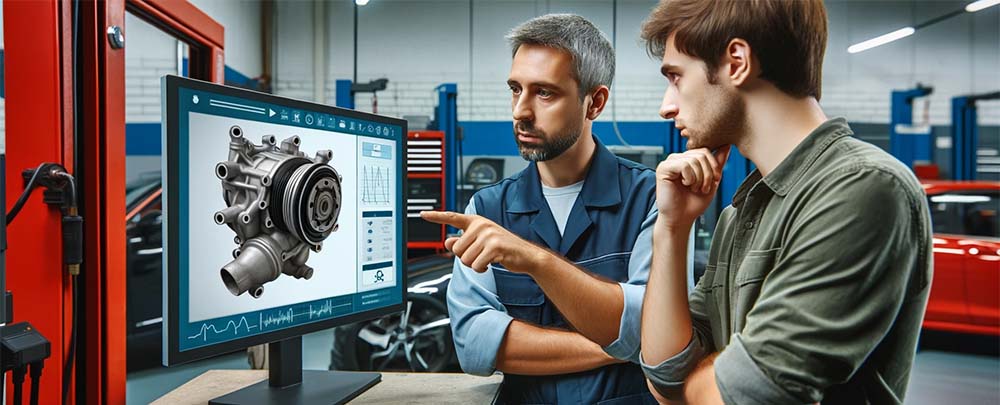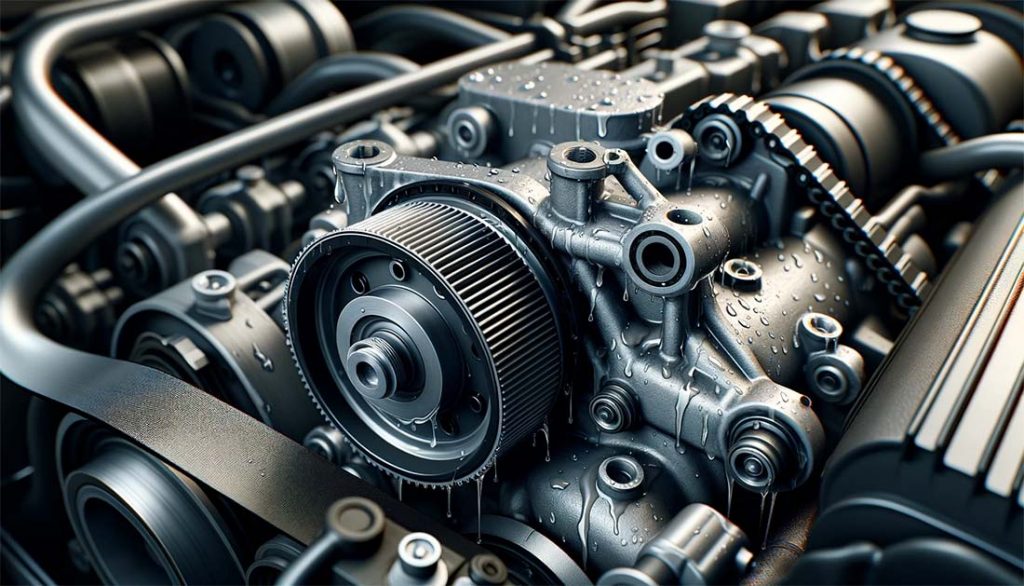The water pump is a vital component of your vehicle’s cooling system, responsible for circulating coolant throughout the engine to maintain optimal operating temperatures. A failing water pump can lead to severe engine overheating, potentially causing extensive and expensive damage. If left unchecked, a malfunctioning water pump can result in catastrophic engine failure, making it crucial to identify and address any issues promptly. In this article, we will explore the telltale signs that indicate your water pump may be failing and provide you with the knowledge to take appropriate action. By understanding the symptoms and taking proactive measures, you can avoid costly repairs and ensure the longevity of your vehicle’s engine.
Understanding the Water Pumps Functionality
Before delving into the symptoms of a bad water pump, it’s essential to understand its role in the cooling system. The water pump is a crucial component that is driven by the engine and is responsible for circulating coolant through the engine block, cylinder heads, and radiator. This continuous flow of coolant helps dissipate the immense heat generated by the engine’s combustion process, preventing overheating and ensuring efficient performance. Without a properly functioning water pump, the coolant would not circulate effectively, leading to a buildup of heat and potentially causing severe damage to the engine components. The water pump’s impeller, seals, and bearings work together to maintain the coolant’s circulation, making it a critical part of the cooling system’s overall operation.
Common Symptoms of a Failing Water Pump
There are several indicators that can signify a failing water pump. Being aware of these symptoms can help you identify potential issues early on and take appropriate action to prevent further damage. Recognizing the warning signs is crucial for maintaining the health and longevity of your vehicle’s engine. By addressing any issues promptly, you can avoid more severe and costly problems from occurring in the future. Ignoring the symptoms of a bad water pump can lead to irreparable engine damage, making it essential to stay vigilant and respond appropriately. The common symptoms of a failing water pump include:
- Coolant leaks around the water pump area or a decrease in the coolant reservoir level
- Unusual whining, grinding, or groaning noises coming from the water pump area
- Engine overheating, indicated by a high temperature gauge reading or warning lights
- Discolored or milky-looking coolant, suggesting the presence of contaminants
Coolant Leaks
One of the most common and easily identifiable signs of a bad water pump is a coolant leak. As the water pump’s seals and gaskets deteriorate over time due to wear and tear, they can allow coolant to escape, leading to a visible leak around the water pump area or a decrease in the coolant reservoir level. A coolant leak can manifest in various ways, such as puddles or stains on the ground near the water pump, a sweet odor emanating from the engine bay, or a noticeable drop in the coolant reservoir level. Regular inspections and monitoring of the coolant level can help detect leaks promptly. If you notice any signs of coolant leakage, it is crucial to have the water pump inspected by a professional mechanic as soon as possible to prevent further damage to the cooling system and engine.
Unusual Noises from the Water Pump Area
A properly functioning water pump should operate with minimal noise, producing only the sound of the coolant flowing through the system. However, if you notice whining, grinding, or groaning sounds coming from the water pump area, it could indicate bearing failure or impeller issues. These noises are often an early warning sign of a failing water pump and tend to worsen as the water pump’s condition deteriorates further. The bearings inside the water pump allow the impeller to spin smoothly and circulate the coolant, while the impeller itself is responsible for propelling the coolant through the system. If these components become worn or damaged, they can produce abnormal noises as they operate. Any unusual noises coming from the water pump area should be investigated promptly, as they can be an early indicator of impending failure.

Engine Overheating
If the water pump is not circulating coolant effectively, it can lead to engine overheating. This is a serious issue that should be addressed immediately, as prolonged overheating can cause severe engine damage, including warped cylinder heads and cracked engine blocks. When the engine overheats, it can lead to a loss of power, decreased fuel efficiency, and potentially catastrophic engine failure if left unchecked. Overheating can occur due to various reasons, such as a faulty thermostat, low coolant levels, or a malfunctioning water pump. If you notice the temperature gauge reading higher than normal or warning lights indicating overheating, it’s crucial to pull over immediately and allow the engine to cool down before inspecting the cooling system for potential issues.
Contaminated Coolant
A failing water pump may also cause contaminants, such as metal shavings or debris, to circulate through the cooling system. This can result in discoloration or a milky appearance in the coolant, indicating the presence of contaminants that could potentially clog or damage other components. When the water pump starts to fail, it can shed small metal particles or other debris into the coolant, which can then circulate throughout the cooling system. Contaminated coolant can lead to reduced cooling efficiency, corrosion, and blockages, exacerbating the problem and potentially causing even more damage. Regular coolant inspections can help identify this issue early on, before it causes further harm to the cooling system and engine.
Inspecting the Water Pump
While some symptoms of a failing water pump may be noticeable from the driver’s seat, a visual inspection of the water pump itself is often necessary to identify potential issues. Look for signs of leakage, cracks, or excessive wear on the water pump housing, pulley, or mounting brackets. Additionally, check for any play or looseness in the water pump shaft, which could indicate bearing failure. A trained mechanic can perform a thorough inspection and identify any issues with the water pump’s components, such as worn seals, damaged impellers, or failing bearings. Inspecting the water pump regularly, especially during routine maintenance, can help catch issues early before they lead to more significant problems.
Preventive Maintenance
Measures To minimize the risk of water pump failure and prolong its lifespan, it’s essential to follow the recommended maintenance schedule for your vehicle. This typically includes:
- Inspecting and replacing the water pump at specific mileage intervals or time periods as specified by the manufacturer.
- Ensuring proper coolant levels and flushing the cooling system regularly to remove contaminants and prevent premature wear.
- Checking for any coolant leaks or signs of wear during routine maintenance.
By adhering to preventive maintenance practices, you can significantly reduce the likelihood of water pump failure and ensure the reliable performance of your vehicle’s cooling system.
Conclusion
Identifying a failing water pump is crucial to avoid costly repairs and potential engine damage. By being aware of the common symptoms, such as coolant leaks, unusual noises, overheating, and coolant contamination, you can take prompt action to address the issue. Regular inspections and preventive maintenance, including timely water pump replacement, can help ensure the longevity and reliable performance of your vehicle’s cooling system. If you suspect any issues with your water pump, do not hesitate to consult a professional mechanic for a thorough diagnosis and repair. Addressing water pump problems early on can save you from more significant and expensive repairs down the line and help maintain the overall health and performance of your vehicle’s engine.

